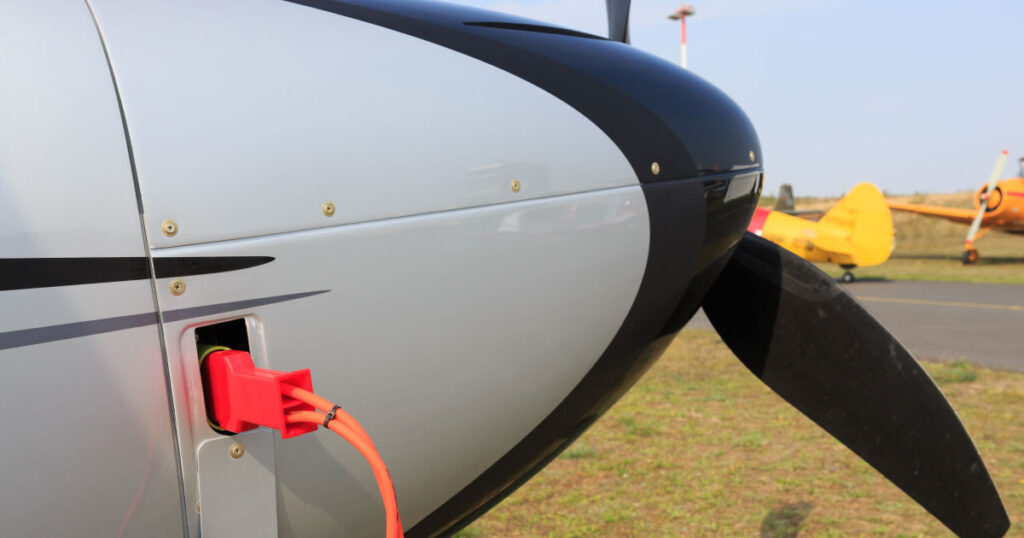Impact
Turning Electric Flight into Reality
Aviation accounts for about 2.5% of global CO2 emissions, and aircraft engineers worldwide are working to turn flying into a cleaner, greener enterprise. Electric flight, however, requires ongoing innovation in two significant areas: lighter, more power-dense batteries, and reduced mechanical friction.
There’s progress on the battery front in the form of solid-state lithium and graphene batteries. On the friction-reduction front, Timken’s recent work on land-based electric vehicle (EV) drive systems and strong aerospace product legacy make it an ideal partner for advancing electric flight.
“We’re at the very beginning of this revolution, and Timken is a preferred partner for many leading aircraft manufacturers,” says Ryan Evans, director of research and development at Timken. “Our aerospace product technologies, including special heat treatments, material choices, and tribological know-how give us a head start on the friction-reduction problems inherent to electric flight.”

Dr. Ryan Evans
Director, Research & Development
Dr. Ryan Evans is director of R&D for The Timken Company. Society of Tribologists and Lubrication Engineers (STLE) president (2022-23) and ASM Fellow, Evans has made significant contributions in the areas of thin film coatings, lubrication, advanced materials characterization and tribology within Timken’s R&D department. He’s authored over 40 technical publications and holds 14 patents.
“Timken’s wear-resistant, thermally managed, high-speed, power-dense, high-load products fit right into what aircraft designers are looking for.”

Mike Gromosiak
Product Manager Aerospace
Mike Gromosiak is aerospace product manager for The Timken Company. Formerly the chief engineer of mobile on-highway, Gromosiak has extensive experience in the automotive industry, including the world’s growing transition to electric vehicles. Today, he applies that expertise to another century-old Timken market — the aerospace industry.
“Material pairs tribology is another area where we offer significant expertise. In our rheology lab, we’ve mapped lubricants for the EV market segment, and also for jet engines.”
Electric flight so far
Solar-powered planes have made occasional headlines since the 1980s, but they’ve been mostly one- or two-seater experimental or training aircraft.
Helicopters have evolved more quickly. Today, major companies around the world are working on four-seater electric vertical take-off and landing (eVTOL) craft for urban air mobility. The biggest hurdle seems to be developing the air traffic infrastructure and regulations to render those Jetsons-style air taxis safe for public airways.
In 2022, aerospace startup Eviation introduced electric flight to the regional market with Alice, its nine-seat commuter plane. After a successful maiden voyage, the company has received hundreds of orders worldwide, with certification and deliveries expected in 2027.
Timken’s enabling technologies
Friction reduction has long been Timken’s core business driver, so Evans and his colleagues see electric flight as one in a series of major advances the company has participated in since its founding.
For nearly 40 years, Timken engineers have worked to increase bearing power density, first for conventional and hybrid vehicles and now for EVs. That technology plays a big role in aerospace, as well. “Timken’s wear-resistant, thermally managed, high-speed, power-dense, high-load products fit right into what aircraft designers are looking for,” says Evans.
New split bearing and ceramic hybrid bearing designs for aerospace are additional technology enablers, uniquely suited to the tight spaces and weight reduction standards required for electric aircraft. “Switching to ceramic rollers gives you a 16-17% reduction in mass, and it fits in the same space as a steel bearing,” says Mike Gromosiak, aerospace product manager at Timken.
“Material pairs tribology is another area where we offer significant expertise,” says Gromosiak. “Our world-class rheology lab has already mapped lubricants for the EV market segment — and also for jet engines.”
Evans and Gromosiak point to Timken’s product validation and testing solutions, as well. “Speed matters when you’re developing new technologies, and our high-speed test rigs can expedite the process for customers by running at realistic application speeds,” says Evans. Timken also has a hybrid bearing life calculation model in the works.
The future of electric flight
Evans looks forward to watching electric aircraft revolutionize commercial flight and reduce its carbon footprint over the next few decades. “There will be an evolution in scale,” he says, “from drones to air taxis to commuter planes and perhaps even large passenger jets one day.”
“I see a demand for highly engineered products and mechanical parts to make it work,” he says. “As we take the friction out and scale down the components, battery needs decrease and that’s a great direction for everybody.”

Read about Timken’s history of aerospace innovation.
Last Updated: 2023/01/31
Published: 2023/01/27
